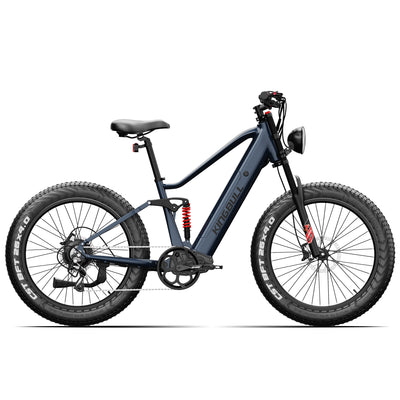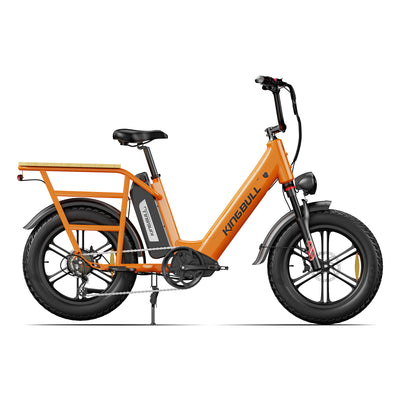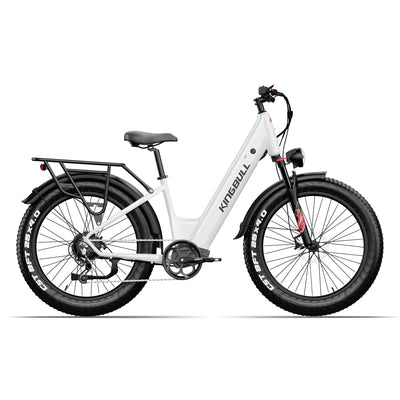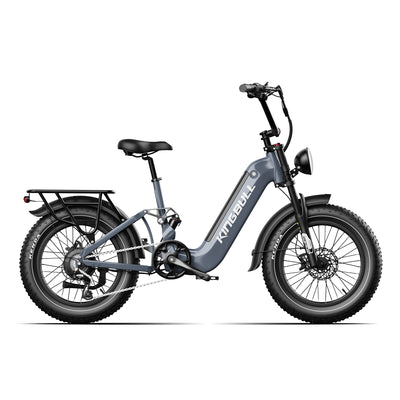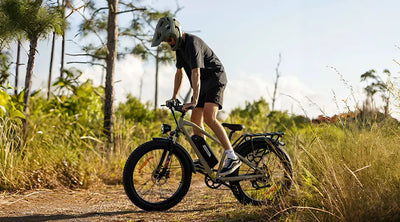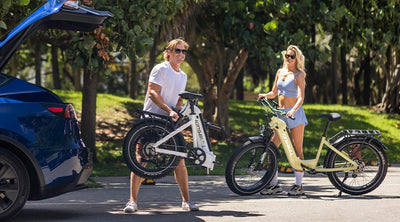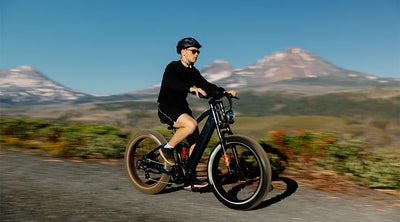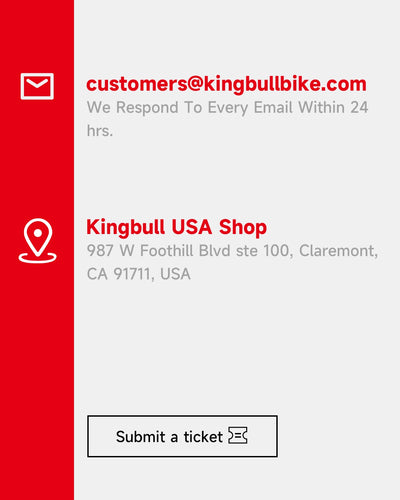Explore News
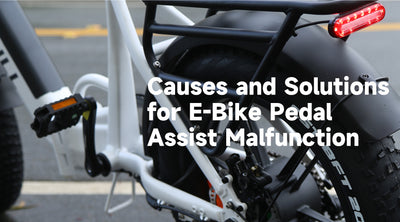
Maintenance
Causes and Solutions for E-Bike Pedal Assist Malfunction
Electric bicycles have seen a surge in popularity, thanks to their eco-friendly nature and the convenience they offer for urban commuting and recreational riding. Central to their appeal is the pedal assist system, which provides riders with an extra boost of power, making cycling easier and more enjoyable. However, like any complex system, the pedal assist can sometimes malfunction, leading to a frustrating disruption in the riding experience. In this blog, we’ll delve into the common causes of pedal assist malfunctions and offer practical solutions to help you get back on the road smoothly.
How the Electric Bicycle Pedal Assist System Works
The pedal assist system on an electric bicycle is a sophisticated technology designed to provide riders with additional power, making cycling easier and more efficient. When a rider begins pedaling, built-in sensors immediately detect changes in pedal force. These sensors are typically located around the pedals or the bike's bottom bracket, and they accurately capture the rider’s effort and cadence. Once the sensor detects the pedal force, it transmits this data to the motor controller.
The motor controller serves as the brain of the system, processing the information received from the sensors and adjusting the motor’s power output accordingly. If the rider increases their effort, such as when climbing a hill or facing strong resistance, the controller automatically boosts the motor’s output, providing more assistance to help the rider conserve energy. Conversely, if the rider reduces their pedaling effort or stops altogether, the controller correspondingly decreases the motor’s output, or even shuts it off when assistance is no longer needed. This intelligent coordination ensures that the electric bicycle delivers a smooth and energy-efficient riding experience by dynamically adjusting power based on the rider's needs.
Common Causes of Pedal Assist Malfunction
Wiring and Connection IssuesThe electrical system of an electric bicycle is complex, with various components interconnected through numerous wires. If there are problems with the wiring or connections between the pedal sensors, controller, or motor, it can disrupt signal transmission. Faulty or loose connections may cause the pedal assist system to malfunction or stop working altogether.
Sensor IssuesThe pedal assist system relies heavily on accurate sensor readings. If the sensors that detect pedal force are damaged, misaligned, or have loose connections, the system may fail to register the rider’s input. This can result in the pedal assist feature not functioning properly, as the system will be unable to respond to the rider's pedaling efforts.
Controller ProblemsThe controller acts as the "brain" of the electric bicycle, interpreting signals from the sensors and managing the motor’s power output. If the controller is malfunctioning, it may fail to process the sensor data correctly, which can prevent the motor from providing the appropriate level of assistance. This issue can lead to inconsistent or non-functioning pedal assist.
Solution
1. Check the Sensor
First, carefully inspect the pedal sensor to ensure there are no visible signs of damage or loose connections. If you find any issues, try reinstalling or replacing the sensor.
Reinstall the Sensor: If the sensor is loosely connected or improperly installed, a correct reinstallation might resolve the issue. Make sure the connection between the sensor and the controller is secure and stable.
Replace the Sensor: If the problem persists after reinstalling the sensor, the sensor itself might be faulty. In this case, please contact our customer support team (customers@kingbullbike.com), and we will send you a replacement sensor.
2. Check the Controller
If both the throttle and pedal assist functions are not working, you should inspect the bike’s controller.
Reinstall the Controller: Try reinstalling the controller to ensure it is properly connected to other components. If the issue persists after reinstalling, the controller may be defective.
Replace the Controller: If reinstalling the controller does not solve the problem, you may need to replace the controller. Please contact customer support for assistance or to obtain a new controller.
How to replace a sensor
To learn how to replace the sensor, please click here for detailed instructions.
Conclusion
The pedal assist system on an electric bicycle greatly enhances the riding experience, but it can malfunction due to various reasons. By understanding common causes of these issues and implementing the appropriate solutions, you can effectively restore the system’s functionality and ensure a smooth and safe ride.
Read more
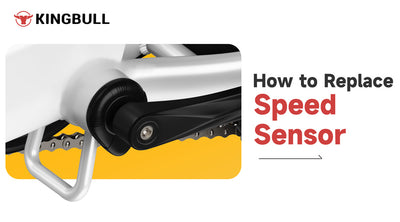
MaintenanceTips & Cycling Knowledge
How to Replace the Speed Sensor on Your Electric Bike: A Step-by-Step Guide
If your electric bike’s speed isn’t showing correctly, the speed sensor might need to be replaced. Luckily, it’s a simple fix you can do yourself with the right tools and a little patience. Here's a quick guide to help you replace it.
Tools You’ll Need
Before you get started, make sure you have the following tools and materials handy:
Hex key
Multi-tool
Crank removal tool
A new speed sensor
Safety Precautions
Disconnect the electric bike’s power to avoid any accidents during the process.
1. Removing the Crank
Step 1: Use the appropriate tool to loosen and remove the bolt securing the crank.
Step 2: Attach the crank removal tool to the crank. Turn the tool clockwise using a hex key until the crank loosens, and then remove it.
2. Removing the Old Speed Sensor
Step 3: Locate the old speed sensor near the crank. It’s usually connected to the controller with a cable.
Step 4: Carefully disconnect the sensor from the controller. Avoid pulling on the cable to prevent damage.
Step 5: Remove the old speed sensor from its position.
3. Installing the New Speed Sensor
Step 6: Place the new speed sensor in the same location as the old one.
Step 7: Reconnect the sensor’s cable to the controller, making sure the connection is secure.
Step 8: Check that the new sensor is properly aligned and won’t rub against the crank or other parts.
4. Reinstalling the Crank
Step 9: Reinstall the crank onto the bike, making sure it’s positioned correctly.
Step 10: Use the multi-tool to securely tighten the bolt that holds the crank in place.
5. Testing the Speed Sensor
Step 11: Reconnect the bike’s power and turn it on.
Step 12: Test the sensor by lifting the rear wheel off the ground and manually rotating the pedals. Check to see if the speed reading is accurate.
6. Troubleshooting
If the speed sensor doesn’t work correctly:
Check the cable connection to ensure it’s tight.
Try recalibrating the sensor.
Wrapping It Up
And that’s it! By following these simple steps, you can replace your electric bike’s speed sensor and get back to enjoying smooth rides with accurate speed readings.If you are unsure or have issues, please feel free to contact kingbull for further assistance.
Read more
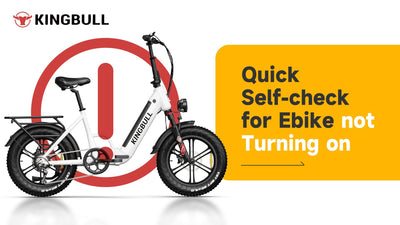
Maintenance
What to Do When Your Ebike Won't Turn On: A Quick Self-Check Guide
What to do when your ebike won't turn on? If you find yourself in this situation, don’t worry! We’ll guide you through a few simple steps to help you get your ebike back up and running quickly.
1. Check the Battery
The first step is to check the battery. Open the battery compartment and make sure the battery has sufficient charge. If the battery is completely discharged, charge it fully and try turning on your ebike again. Sometimes, a battery that is not properly seated can also cause power issues, so ensure it is securely in place.
2. Inspect the Display Cable
Next, inspect the display cable. Locate the cable connecting the display to the main system. Unplug it and check for any visible damage or wear. If the cable looks intact, reconnect it carefully, making sure to align the directional arrows. A loose or damaged display cable can prevent the ebike from turning on, so this is an important step.
3. Examine the Controller Connections
The controller is a crucial component of your ebike’s electrical system, and it is usually located in the middle of the frame. For foldable models, you may need to fold the ebike to access the controller. Use a tool to remove the controller cover and inspect the wiring connections for any signs of damage or disconnection. If everything looks good, reconnect the wires securely. Faulty or loose connections at the controller are often the cause of power issues.
Conclusion
Any of these three simple checks can help diagnose and resolve the issue preventing your ebike from turning on. In most cases, a quick adjustment is all it takes to get back on the road.
If you have any further questions or need additional assistance, please don't hesitate to contact our customer service team. And, of course, be sure to check out our YouTube channel for more helpful ebike tips and tricks!
Read more
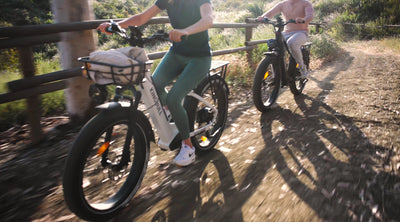
MaintenanceTips & Cycling Knowledge
How to Inflate Your Electric Bike Tires: A Step-by-Step Guide
All electric bikes, like regular bikes, need to inflate their tires when they are low on air pressure.Keeping your electric bike tires properly inflated is crucial for a smooth and safe ride. Whether you're a seasoned e-biker or new to the scene, this guide will walk you through the process of inflating your electric bike tires. Let’s dive in!
Why Proper Tire Inflation Matters
Before we get into the steps, it's important to understand why tire inflation is so crucial:
Safety: Properly inflated tires provide better grip and control.
Performance: Correct tire pressure ensures a smoother ride and better efficiency.
Longevity: Well-maintained tires last longer and are less prone to damage.
Step-by-Step Guide to Inflating Your Electric Bike Tires
Step 1: Gather Your Tools
You'll need:
A quality bike pump
A pressure gauge (if your pump doesn’t have one)
Your electric bike’s tire pressure recommendations (found in the manual or on the tire sidewall)
Step 2: Check the Recommended Tire Pressure
Look on the sidewall of your tires for the recommended PSI (pounds per square inch). This information is also usually found in your bike’s user manual. Ensuring you know the correct PSI is essential for avoiding over or under-inflation.
Step 3: Remove the Valve Cap
Locate the valve on your tire. There are two common types of valves:
Schrader Valve: The same type found on car tires.
Presta Valve: A narrower, often found on road bikes. If your bike has Presta valves, you’ll need to unscrew the small knurled nut at the top before you can pump air in.
Step 4: Attach the Pump
For a Schrader valve, simply press the pump head onto the valve and secure it.
For a Presta valve, after unscrewing the knurled nut, press the pump head onto the valve and secure it, usually by flipping a lever.
Step 5: Inflate the Tire
Begin pumping. Keep an eye on the gauge to ensure you’re adding the correct amount of air.
If your pump has a gauge, you’ll see the pressure rising as you pump. If not, periodically check the pressure with a separate gauge.
Step 6: Check the Pressure
Stop pumping occasionally to check the pressure. Ensure it matches the recommended PSI.
For Schrader valves, use the pressure gauge directly.
For Presta valves, close the knurled nut first, then check the pressure if using a separate gauge.
Step 7: Secure the Valve and Replace the Cap
Once your tire is inflated to the correct pressure:
Remove the pump head.
For Presta valves, screw the knurled nut back down.
Replace the valve cap on either type.
Step 8: Repeat for the Other Tire
Don’t forget to repeat the process for your rear tire!
Tips for Maintaining Tire Pressure
Regular Checks: Check your tire pressure at least once a month, or before long rides.
Weather Considerations: Tire pressure can fluctuate with temperature changes, so check more frequently in extreme weather.
Carry a Portable Pump: A compact, portable pump can be a lifesaver if you need to adjust pressure on the go.
Conclusion
Keeping your electric bike tires properly inflated is a simple yet essential task that enhances your riding experience and safety. By following these steps, you'll ensure your tires are always in top condition, ready for any adventure. Happy riding!
Read more

MaintenanceTips & Cycling Knowledge
The Complete Guide to E-Bike Seat Adjustment: Key Tips for Comfort and Fit
When it comes to the comfort of electric bicycles, seat adjustment is of paramount importance. A properly adjusted seat not only enhances the riding experience but also helps reduce the discomfort that may arise from prolonged use.
Adjusting Seat Height
The adjustment of seat height directly affects the rider's comfort and riding efficiency. An appropriate seat height should allow the rider's knees to be slightly bent while pedaling, avoiding discomfort caused by fully extended or overly bent knees. Seat height adjustment can be accomplished by modifying the length of the seat post, ensuring optimal power output and stability during the ride.
Common Issues and Solutions
Some customers have reported that the seat cannot be secured even after tightening the seat post clamp. This issue often arises because the seat is not adjusted to the correct position relative to the marking on the seat post. The seat should be adjusted within the marked range—neither below nor above the marking.
If the seat still cannot be fixed even after adjusting according to the marking, the issue might lie with the seat post clamp itself. In this case, you should:
Open the seat post clamp.
Tighten the screw of the seat post clamp.
Secure the seat post clamp again.
Following these steps should ensure that the seat remains securely in place after adjustment.
Seat Material and Design
When considering the material and design of bicycle seats, aside from adjustment functionalities, several factors contribute to comfort. A comfortable seat should offer adequate support and softness to reduce friction and pressure during long rides. It should also be breathable to wick away moisture, keeping riders dry and comfortable.
When purchasing a seat, it is crucial to consider its size and compatibility with your bike's seat post. The seat is usually secured with a seat clamp, which attaches to the seat post. The size of the clamp that secures the seat is approximately 4.8 cm, while the width of the seat post on the bike is 2.8 cm, ensuring a stable installation. If you are only adding a comfortable seat cover to the seat, you can choose based on personal preference without affecting compatibility with the seat post.
When carrying passengers, ensuring safety is paramount. Installing a rear seat armrest on the seat post can significantly enhance safety by providing passengers with a stable support to hold onto. This can help prevent injuries and maintain balance during sudden braking, sharp turns, or other unexpected movements. Additionally, a rear seat armrest can offer added comfort for passengers, making the ride more enjoyable. Ensuring the armrest is securely installed and made from durable materials is crucial to maximize its effectiveness in enhancing passenger safety.
Conclusion
A well-adjusted electric bicycle seat not only enhances riding comfort but also mitigates potential health issues and fatigue. This allows riders to fully enjoy the benefits and pleasure of cycling.
Read more
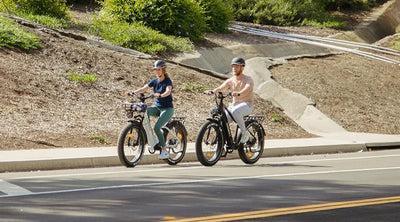
MaintenanceTips & Cycling Knowledge
Why My Electric Bike Won't Start After Delivery: Common Issues and Solutions
Upon receiving their electric bike, many customers report that despite charging the battery, their bike fails to start or the throttle doesn't respond, much like a traditional bike. This issue can be frustrating, especially after eagerly anticipating the arrival of a new mode of transportation. Understanding the common problems and their solutions can help resolve these issues quickly and get you back on the road.
Reasons Why Your Electric Bike Won't Start
Battery is Depleted
The first thing you should do after receiving your electric bike is to check the battery level. Long press the button in the middle of the battery. If the indicator light does not turn on, it means the battery is depleted.
Light Status
Battery Status
3 Green Lights & Red Light
80% -100% Power
2 Green Lights & Red Lights
60% - 80% Power
1 Green Lights & Red Lights
40% - 60% Power
Only Red Light
20% - 40% Power
No Light
0% Power
Battery is Still Charging
During the first charge after receiving their electric bike, After charging, they forget to unplug the charging cable before turning on the power, which prevents the bike from starting.
Power Switch on the Right Side of the Battery is Not Turned On
There is a power switch on the right side of the battery that needs to be switched to the "I" position to turn on the power.
Instrument Panel Power Button on the Left Handlebar is Not Pressed
Typically, electric bikes require a long press of the power button to activate the electric assist, similar to how a car needs to be started before it can run. The same applies to your bike; you need to long press the power button on the left handlebar to activate the display.
How to Start an Electric Bike
Activate the Battery:
Turn the red switch on the right side of the battery to the "l" position to power it on.
Check Battery Level:
Press and hold the button in the middle of the battery to check the current battery level.
Power On the E-Bike:
Press and hold the power button located next to the left handlebar to activate the e-bike.
Adjust Pedal Assist:
Briefly press the "+" or "-" buttons to adjust the pedal assist level according to your preference, ranging from levels 1 to 5.If the pedal assist level is set to 0, the electric bike will not operate.
Conclusion
If you have followed all the troubleshooting steps and your electric bike still won't start, don't hesitate to reach out to our customer service team at email customers@kingbullbike.com for further assistance. We are committed to ensuring that your riding experience is smooth and enjoyable. Remember, proper maintenance and understanding your e-bike's functions can prevent many common issues. Thank you for choosing Kingbull Bike, and happy riding.
Read more




